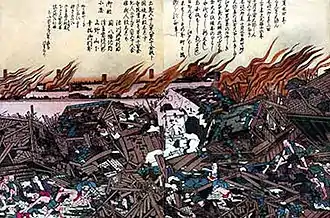1855 Edo earthquake
The 1855 Edo earthquake (安政江戸地震, Ansei Edo Jishin), was the third Ansei Great Earthquake, which occurred during the late-Edo period.[3] It succeeded the 1854 Nankai earthquake, which took place about a year prior. The earthquake occurred at 22:00 local time on 11 November. It had an epicenter close to Edo (now Tokyo), causing considerable damage in the Kantō region from the shaking and subsequent fires, with a death toll of 7,000–10,000 people and destroyed around 14,000 buildings.[4][2] The earthquake had a magnitude of 7.0 on the surface wave magnitude scale and reached a maximum intensity of XI (Extreme) on the Mercalli intensity scale.[1][5] The earthquake triggered a minor tsunami.
  | |
| Local date | November 11, 1855 |
|---|---|
| Local time | 22:00 |
| Magnitude | 7.0 Ms[1] |
| Epicenter | 35.65°N 139.8°E |
| Areas affected | Japan, Tokyo |
| Tsunami | minor |
| Casualties | ~7,000 |


Tectonic setting
The Kanto area lies above a complex part of the convergent boundaries between the subducting Pacific and Philippine Sea Plates and the overriding Eurasian and North American Plates. Earthquakes with epicenters in the Kanto region may occur within the Eurasian Plate, at the Eurasian Plate/Philippine Sea Plate interface, within the Philippine Sea Plate, at the Philippine Sea Plate/North American Plate interface (under the Sagami Trough), at the Philippine Sea Plate/Pacific Plate interface (Izu-Bonin-Mariana Arc), or within the Pacific Plate. In addition to this set of major plates it has been suggested that there is also a separate 25 km thick, 100 km wide body, a fragment of Pacific Plate lithosphere.[6]
The cause of the 1855 earthquake is unknown; it is consistent with a rupture along the interface between the Eurasian and Philippine Sea Plates, adjacent to, and down dip from, the rupture that caused the 1923 Great Kantō earthquake.[7]
Damage
A total of about 50,000 houses and over 50 temples were either destroyed by the earthquake shaking or subsequent fires.[1] The area burned down in Edo was about 2.3 km2.[5] The earthquake’s destruction and associated death toll were especially great for the time, as Ansei Tokyo was composed largely of plaster-and-tile structures that were resistant to fires but prone to tremors. In spite of Japan’s long history with earthquakes, as of 1855 Tokyo had not experienced a major quake for about 154 years; in the minds of the citizenry, earthquakes were either a thing of the past or simply too unlikely to reasonably plan for. This lack of structural preparation, combined with the fact that most of the well-populated areas of Tokyo were built on former wetlands artificially filled in with unstable alluvial soil, left the city undefended from the massive force of the Ansei quake.[8]
Characteristics
The earthquake was followed by 78 aftershocks in the first month.[7]
Aftermath
Two days after the earthquake, prints began to appear, with more than 400 different types being available in the following weeks. Most of the prints depicted giant catfish, a type of image known as Namazu-e. The significance being that earthquakes at the time were popularly attributed to the thrashing about of a mythological catfish under the earth, normally kept under control by the deity Kashima using a large rock.[2] The number of prints produced during the 1855 earthquake was unprecedented and has been related to the political and social effects of the disaster. The prints show the people's anger with Kashima who became replaced by the solar deity Amaterasu. Some of the prints also depict the redistribution of wealth. The earthquake has been described as an act of yonaoshi or 'world rectification', in the light of the two great earthquakes of 1854 and the arrival of Perry's Black Ships in 1853.[2]
Era of disaster
Three large earthquakes, the 1854 Ansei-Tōkai earthquake, 1854 Ansei-Nankai earthquake, and the 1855 Ansei Edo earthquake are collectively called the Ansei great earthquakes (安政の大地震, Ansei no Dai Jishin). Combining the effects of these disasters with a major cholera outbreak killing over 100,000 people, a fire at Edo Castle, and the 1858 Hietsu earthquake, the Ansei era was one of quite catastrophic upheaval. Due to the cumulative effects of these disasters, the reign name was changed in 1860 to usher in a 'clean slate' and better "fortune".
See also
- List of earthquakes in Japan
- List of historical earthquakes
- List of historical tsunamis
Notes
- NGDC. "Comments for the Significant Earthquake". Retrieved 27 August 2010.
- Smits, Gregory (Summer 2006). "Shaking up Japan: Edo Society and the 1855 Catfish Picture Prints" (PDF). Journal of Social History. 39 (4). Archived (PDF) from the original on 5 November 2010. Retrieved 28 October 2010.
- _____. (2007). "Great Earthquakes of Ansei" (安政大地震, Ansei Daijishin) in Historical Encyclopedia of Great Edo (大江戸歴史百科, Ō-Edo Rekishi Hyakka), p. 253.
- Smits, Gregory (2006-01-01). "Shaking up Japan: Edo Society and the 1855 Catfish Picture Prints". Journal of Social History. 39 (4): 1045–1078. doi:10.1353/jsh.2006.0057. JSTOR 3790240.
- Enomoto, T. (1987). "Study on the distribution of seismic intensity of the 1855 Ansei Edo earthquake in the Kanto District" (PDF). Structural Engineering/Earthquake Engineering. 4 (1): 175s–195s. Retrieved 27 October 2010.
- Toda, S.; Stein R.S., Kirby S.H. & Bozkurt S.B. (2008). "A slab fragment wedged under Tokyo and its tectonic and seismic implications". Nature Geoscience. 1 (11): 771–776. Bibcode:2008NatGe...1..771T. doi:10.1038/ngeo318.
- Bakun, W.H. (2005). "Magnitude and location of historical earthquakes in Japan and implications for the 1855 Ansei Edo earthquake" (PDF). Journal of Geophysical Research. 110 (B02304). Bibcode:2005JGRB..11002304B. doi:10.1029/2004JB003329. Retrieved 27 October 2010.
- Gregory Smits. Seismic Japan: The Long History and Continuing Legacy of the Ansei Edo Earthquake Link label. Honolulu: University of Hawai'i Press, 2013. ISBN 978-0-8248-3817-1.
References
- _____. (2007). "Great Earthquakes of Ansei" (安政大地震, Ansei Daijishin) in Historical Encyclopedia of Great Edo (Ō-Edo Rekishi Hyakka). Tokyo: Kawade Shobō Shinsha Publishers. ISBN 9784309224671 OCLC 192046093
- Gregory Smits. Seismic Japan: The Long History and Continuing Legacy of the Ansei Edo Earthquake Link label. Honolulu: University of Hawai'i Press, 2013. ISBN 978-0-8248-3817-1.
